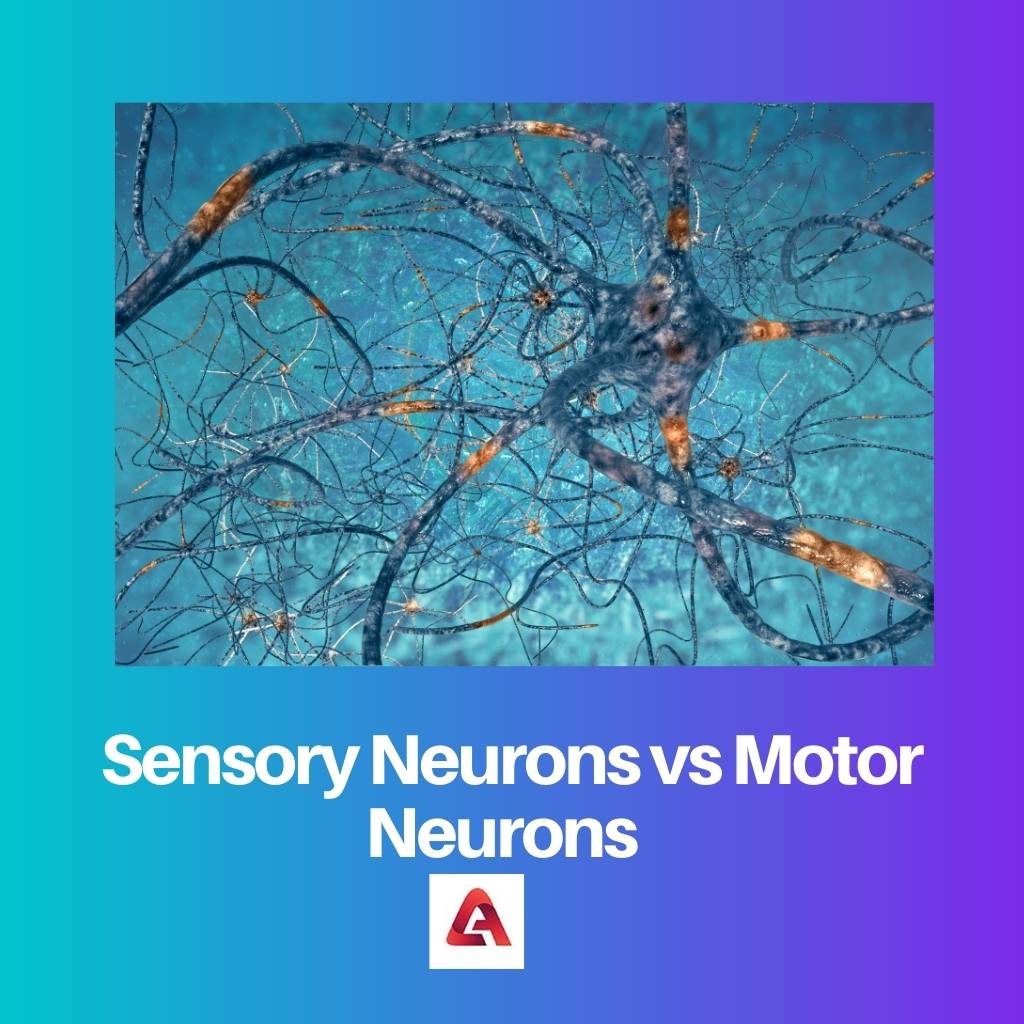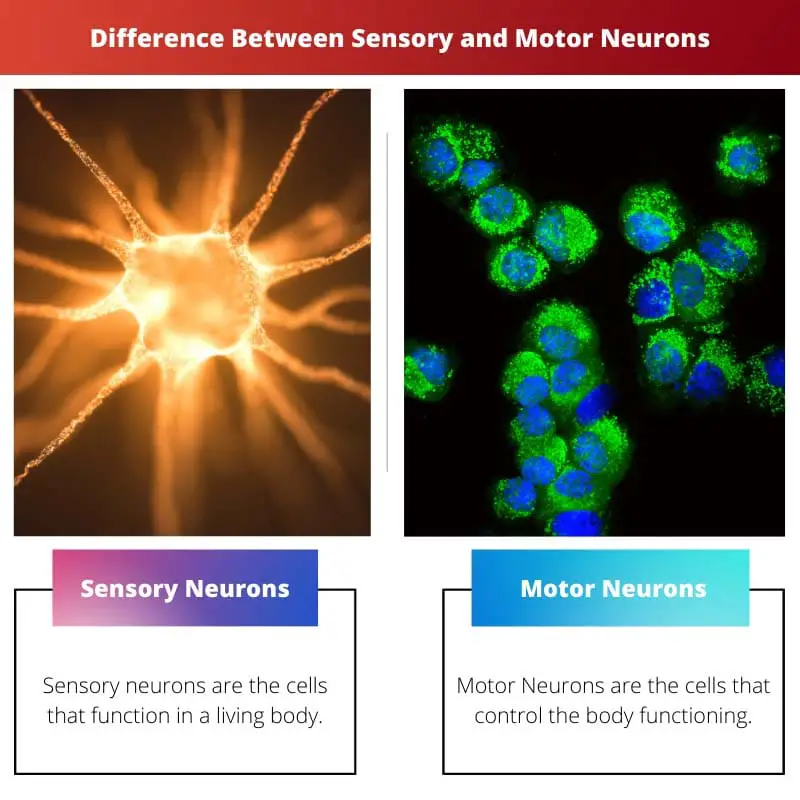Our body consists of various organs that help in functioning. Our work depends on the body’s functioning. Neurons are the cells that function in our bodies.
Key Takeaways
- Sensory neurons transmit information from the sensory organs to the brain and spinal cord.
- Motor neurons transmit information from the brain and spinal cord to the muscles and glands.
- Sensory neurons are afferent, while motor neurons are efferent.
Sensory Neurons vs Motor Neurons
The difference between Sensory Neurons and Motor Neurons is that Sensory Neurons will activate by input from the environment. In Contrast, Motor neurons had located in the nervous system that controls the different downstream targets. The structure and processing of both Sensory and Motor Neurons are different.

Sensory Neurons are the neuron cells that activate the sensory cells from environments. The activities from the environment go into our body through sensory neurons.
Motor Neurons are the nerve cells that had located in the Nervous System. Motor Neurons help in controlling the various downstream targets.
Comparison Table
| Parameters of Comparison | Sensory Neurons | Motor Neurons |
|---|---|---|
| Meaning | Sensory neurons are the cells that function in a living body. | Motor Neurons are the cells that control the body functioning. |
| Location | Sensory Neurons had placed in the dorsal ganglia of the spinal cord of an individual. | Motor Neurons had located in the spinal cord that connects with the nervous system. |
| Commands | Sensory Neurons controls the cells help to find the senses in the spinal cord. | Motor Neurons control the muscles, organs, glands and control muscle movements. |
| Function | Sensory Neurons activates from the surroundings and send signals to the nervous system that the information they had received. | Motor Neurons located in the nervous system transmit to the organs, glands and controls all the muscular movements. |
| Difference | Sensory Nerve cells are comprising a short axon, and their function is different. | Motor Neurons comprise a long axon compared with Sensory Neurons. |
What are Sensory Neurons?
Sensory Neurons are the cells that activate the sensory input from environmental activities.
These neuron cells had located in the dorsal ganglia in the spinal cord. The Sensory Neurons cells in the spinal cord of the human body had used to connect with the nervous system.
Sensory Neurons are of five types that help in functioning. The 5 classes of sensory neurons are;
- Mechanoreceptors
- Thermoreceptors
- Nociceptors
- Electromagnetic receptors
- Chemoreceptors
The above classes are the cells divided on their location, morphology, and depending on their response. Brain Neurons involve in sensory processing, where the visual or auditory cortex will respond to the sensory neurons.
The neurons communicate, and an electrical impulse releases the neurotransmitters. The neurotransmitters reach to bind the Special Molecules bypassing the synapse.
- Touching a hot surface
- Experiencing coldness
- Can find sweat
Many senses are getting into the brain through the sensory nerves. We can find the sensory nerves in the retina of the eye, olfactory epithelium, and ganglia.

What are Motor Neurons?
Motor Neurons are the nerve cells that had located in the nervous system. Motor Neurons help in controlling the downstream targets of the nervous system.
Motor Neurons had connected to muscles, organs, and glands in a living body and control all the movements of the muscles.
The process and construction of the Motor Neurons cells are different from the sensory nervous system. There are 5,00,000 Motor Neurons in the human body, and it carries from the central nervous to the organ systems.

Main Differences Between Sensory and Motor Neurons
- We find both Sensory and Motor Neurons in the spinal cord in our body, but both are different in their way of functioning.
- Sensory Neurons involve short axons, whereas Motor Neurons include long axons.

- https://www.jbc.org/article/S0021-9258(18)92088-0/abstract
- https://www.jneurosci.org/content/17/1/470.short
- https://www.sciencedirect.com/science/article/pii/S0304394016308436

The role of sensory nerves in transmitting various senses is fundamental to our perceptions. It’s remarkable how these neurons contribute to our sensory experiences.
Absolutely, the sensory neurons play a critical role in relaying sensory information to our brain. This helps us interpret and respond to various stimuli.
The classification of the types of neurons is quite intriguing. It helps explain how each type contributes to our overall sensory and motor functions.
Absolutely. Understanding the differences between sensory and motor neurons further highlights the complexity and coordination required for the human body’s proper functioning.
It’s remarkable how specific the functionalities of sensory and motor neurons are. This article provides a clear and detailed comparison of their roles.
The references provided in the article add credibility to the information. It’s commendable to see thorough sourcing, adding depth to the topic.
The scientific references cited in the article contribute to its reliability and validity. It’s essential to have evidence-based information on such intricate subjects.
The involvement of sensory neurons in sensory processing and the transmission of electrical impulses is captivating. It’s incredible to see how our bodies interpret various sensory inputs.
The complexity of sensory neuron activities, as described in the article, underscores the intricate processes that enable us to perceive and understand the world around us.
Absolutely. The article effectively highlights the mechanisms through which sensory neurons process and relay information, enhancing our comprehension of sensory experiences.
The differences in axon length and other structural aspects between sensory and motor neurons illustrate the specialization required for their distinct functions.
The intricate details about sensory and motor neurons provide a deeper understanding of the mechanisms underlying the body’s sensory and motor functions.
Indeed, the unique characteristics of sensory and motor neurons are essential for the diverse tasks they perform. This article did an excellent job of highlighting these differences.
Neurons are such a remarkable part of our body’s functions. They are responsible for the way we perceive the world in so many ways.
Indeed. It’s fascinating how complex the neurons’ processes are and how much they contribute to everyday bodily functions.
The details in this article provide a comprehensive understanding of sensory and motor neurons. It’s incredible how they enable us to perceive and interact with our environment.
The comprehensive explanation of sensory and motor neurons inspires a deeper appreciation for the fundamental roles they play in our bodies’ everyday functions.
Indeed, the detailed insights into the workings of sensory and motor neurons enrich our understanding of the human body’s intricate nervous system and its intricate processes.
The information about mechanoreceptors, thermoreceptors, nociceptors, electromagnetic receptors, and chemoreceptors is very enlightening. It shows the diverse range of sensory responses we have.
The involvement of different sensory neurons in perception is truly fascinating. Each receptor type has a unique purpose and function within the body’s sensory processes.
The impact of sensory neurons on our sensory experiences, as described in the article, emphasizes their crucial role in how we interact with the world around us.
The differences between sensory and motor neurons are outlined with great clarity. Their distinct roles and mechanisms in the nervous system are crucial for understanding our bodily functions.
Absolutely. The detailed comparison provided in this article helps in comprehending the significance of each type of neuron and how their functions contribute to our overall biological processes.
I agree. The information presented highlights the complexity and intricacy of neural processes, shedding light on their vital contributions to our daily activities.
Understanding the structure and functions of neurons, particularly motor neurons, provides key insights into how our body carries out movements and actions.
Definitely, the significance of motor neurons in controlling muscle movements and organ functions cannot be overstated. This article provides valuable information on their essential roles.